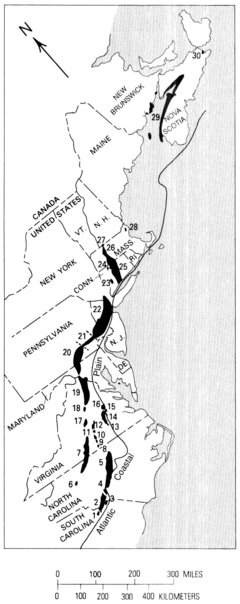| Newark Supergroup | |
|---|---|
| Stratigraphic range: Triassic - Jurassic | |
 Exposed basins of the Newark Supergroup | |
| Type | Supergroup |
| Sub-units | see text |
| Location | |
| Region | East Coast, The Maritime Provinces |
| Country | |
| Extent | Nova Scotia, New Brunswick, Massachusetts, Connecticut, New York, New Jersey, Pennsylvania, Maryland, Virginia, North Carolina, and South Carolina |
| Type section | |
| Named for | Newark, New Jersey |
The Newark Supergroup, also known as the Newark Group, is an assemblage of Upper Triassic and Lower Jurassic sedimentary and volcanic rocks which outcrop intermittently along the east coast of North America. They were deposited in a series of Triassic basins, the Eastern North American rift basins, approximately 220–190 million years ago.[1][2] The basins are characterized as aborted rifts, with half-graben geometry, developing parallel to the main rift of the Atlantic Ocean which formed as North America began to separate from Africa. Exposures of the Newark Supergroup extend from South Carolina north to Nova Scotia. Related basins are also found underwater in the Bay of Fundy. The group is named for the city of Newark, New Jersey.
- ^ Traverse, Alfred (1988). Paleopalynology. Unwin Hyman. ISBN 0045610010. OCLC 17674795.
- ^ Luttrell, Gwendolyn W. (1989). "Stratigraphic nomenclature of the Newark Supergroup of eastern North America" (PDF). U.S. Geological Survey Bulletin. 1572: 1–136. Retrieved 30 June 2018.
